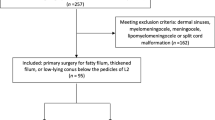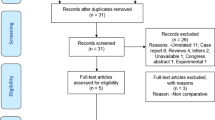Abstract
Purpose
Retethering after transection of a tight filum terminale (TFT) deemed to be a rare and usually only years after initial surgery occurring complication. Possible perioperative factors that might influence the retethering rate or help to allow a prognostic risk assessment are still poorly investigated. The aim of this study was to analyze our patient cohort who underwent a TFT transection by assessing clinical outcome, retethering rate, and pre- and postoperative MRI studies.
Methods
All consecutive patients undergoing transection of a TFT from January 2011 to December 2018 were evaluated. Inclusion criteria were defined as exclusive TFT intervention and a minimum follow up period of 1 year. Epidemiological data, treatment modalities, complication characteristics, and MRI studies were recorded and analyzed.
Results
A total of 58 patients met our inclusion criteria. The retethering rate in our patient cohort was 5.2% (3/58); one of the three patients developed two episodes of a retethering. Patients with an unchanged conus level, no improvement in the syringomyelia, and an unchanged thickness of the spinal cord postoperatively seem to have a significant higher risk to develop a retethering episode in the follow-up.
Conclusion
Retethering after transection of the filum terminale did occur more often than expected. Certain existing factors on the routine postoperative MR images may help to identify patients with an increased likelihood to develop a retethering episode. These results may contribute to improve the follow-up for patients after transection of a TFT and may facilitate adequate treatment.




Similar content being viewed by others
Explore related subjects
Discover the latest articles and news from researchers in related subjects, suggested using machine learning.References
Lew SM, Kothbauer KF (2007) Tethered cord syndrome: an updated review. Pediatr Neurosurg 43:236–248
Yamada S, Won DJ, Pezeshkpour G, Yamada BS, Yamada SM, Siddiqi J, Zouros A, Colohan AR (2007) Pathophysiology of tethered cord syndrome and similar complex disorders. Neurosurg Focus 23:E6
Yamada S, Won DJ, Yamada SM (2004) Pathophysiology of tethered cord syndrome: correlation with symptomatology. Neurosurg Focus 16:E6
Yamada S, Zinke DE, Sanders D (1981) Pathophysiology of “tethered cord syndrome”. J Neurosurg 54:494–503
Liu FY, Li JF, Guan X, Luo XF, Wang ZL, Dang QH (2011) SEM study on filum terminale with tethered cord syndrome. Childs Nerv Syst 27:2141–2144
Selcuki M, Vatansever S, Inan S, Erdemli E, Bagdatoglu C, Polat A (2003) Is a filum terminale with a normal appearance really normal? Childs Nerv Syst 19:3–10
Tortori-Donati P, Rossi A, Cama A (2000) Spinal dysraphism: a review of neuroradiological features with embryological correlations and proposal for a new classification. Neuroradiology 42:471–491
Usami K, Lallemant P, Roujeau T, James S, Beccaria K, Levy R, Di Rocco F, Sainte-Rose C, Zerah M (2016) Spinal lipoma of the filum terminale: review of 174 consecutive patients. Childs Nerv Syst 32:1265–1272
Ogiwara H, Lyszczarz A, Alden TD, Bowman RM, McLone DG, Tomita T (2011) Retethering of transected fatty filum terminales. J Neurosurg Pediatr 7:42–46
Ostling LR, Bierbrauer KS, Kuntz C (2012) Outcome, reoperation, and complications in 99 consecutive children operated for tight or fatty filum. World Neurosurg 77:187–191
Vassilyadi M, Tataryn Z, Merziotis M (2012) Retethering in children after sectioning of the filum terminale. Pediatr Neurosurg 48:335–341
Yong RL, Habrock-Bach T, Vaughan M, Kestle JR, Steinbok P (2011) Symptomatic retethering of the spinal cord after section of a tight filum terminale. Neurosurgery 68:1594–1601 discussion 1601-1592
Inoue M, Uchida K, Otake K, Nagano Y, Shimura T, Hashimoto K, Matsushita K, Koike Y, Matsubara T, Kusunoki M (2017) Long-term functional outcome after untethering surgery for a tethered spinal cord in patients with anorectal malformations. Pediatr Surg Int 33:995–999
Kanev PM, Lemire RJ, Loeser JD, Berger MS (1990) Management and long-term follow-up review of children with lipomyelomeningocele, 1952-1987. J Neurosurg 73:48–52
Souweidane MM, Drake JM (1998) Retethering of sectioned fibrolipomatous filum terminales: report of two cases. Neurosurgery 42:1390–1393
Samuels R, McGirt MJ, Attenello FJ, Garces Ambrossi GL, Singh N, Solakoglu C, Weingart JD, Carson BS, Jallo GI (2009) Incidence of symptomatic retethering after surgical management of pediatric tethered cord syndrome with or without duraplasty. Childs Nerv Syst 25:1085–1089
Halevi PD, Udayakumaran S, Ben-Sira L, Constantini S (2011) The value of postoperative MR in tethered cord: a review of 140 cases. Childs Nerv Syst 27:2159–2162
Oi S, Yamada H, Matsumoto S (1990) Tethered cord syndrome versus low-placed conus medullaris in an over-distended spinal cord following initial repair for myelodysplasia. Childs Nerv Syst 6:264–269
Ohe N, Futamura A, Kawada R, Minatsu H, Kohmura H, Hayashi K, Miwa K, Sakai N (2000) Secondary tethered cord syndrome in spinal dysraphism. Childs Nerv Syst 16:457–461
Author information
Authors and Affiliations
Corresponding author
Ethics declarations
Conflict of interest
The authors declare that they have no conflict of interest.
Additional information
Publisher’s note
Springer Nature remains neutral with regard to jurisdictional claims in published maps and institutional affiliations.
Rights and permissions
About this article
Cite this article
Finger, T., Schaumann, A., Grillet, F. et al. Retethering after transection of a tight filum terminale, postoperative MRI may help to identify patients at risk. Childs Nerv Syst 36, 1499–1506 (2020). https://doi.org/10.1007/s00381-019-04458-9
Received:
Accepted:
Published:
Issue Date:
DOI: https://doi.org/10.1007/s00381-019-04458-9




